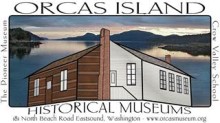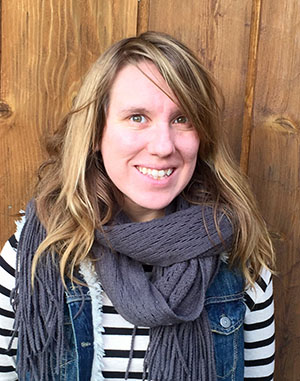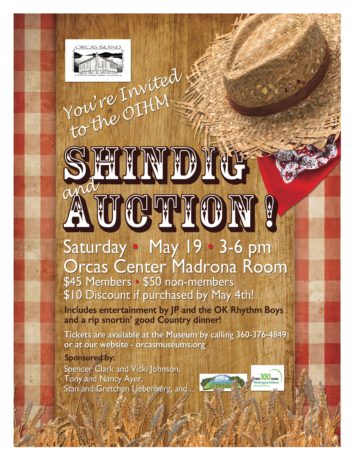— by Matt Willis, Orcas Issues reporter —
Unlike museums that simply serve as a place to view aging relics, the Orcas Island Historical Museum is the home and loving archive for our Island’s stories – stories that resonate strongly with long-time islanders, part-timers, and visitors alike. The museum’s unique perspective is only fitting given that it’s been housed since 1950-s in 6 homestead cabins.
Brittney Maruska, the new Executive Director of the museum, says, “We’re a place where the island’s history is stored and its stories are discovered, researched and preserved. Each week we receive research requests from locals about land, photos, and people that lived here at one point. Community members regularly donate items from their possession to be preserved by the museum and appreciated by the community and visitors for future generations.
“We also host the Oral History Project, where we give families a recorder and software applications to perform interviews with family members, and then make transcripts for the museum. We’d like to start doing this for the island’s many organizations too. Many of the museum’s stories are crowd-sourced.”
Maruska is a Pacific Northwest local…born and raised in Bellingham. She attended Western University where she received a degree in anthropology. Afterwards, she studied Arts and Nonprofit Management at the University of Oregon before moving to Denver where she worked for an association management company running non-profits, their conferences and educational programs. She also served on their boards and committees. Then the call home came.
“We moved back to Washington to be close to family and friends, while my husband made a transition to the tech industry. My husband, beloved dog and I have lived on Orcas for two years,” said Brittney. “I’ve been blown away by how much the Orcas community has accomplished on its own…how they’ve bettered the island and support each other. A great example of this is the museum itself. It was all started by community members, literally on someone’s porch. They organized a Historical Day Parade and it all came together from there. Very grassroots. And, there’s so much to do here: speakers, festivals, performances, pot lucks and parades. It’s all organized from the ground up!”
And coming right up is the Shindig/Auction for the Historical Museums, on Saturday May 19 at Orcas Center’s Madrona Room from 3 to 6 p.m. Tickets are $45 for Museum members and $50 for non-members and the event promises entertainment by JP and the OK Rhythm Boys and a “rip snortin’ good Country dinner>”
The Orcas Island Historical Museum’s humble beginnings go back to the 1951 formation of the Orcas Island Historical Society. During the first six years the museum was actually housed in William Langell’s home. It wasn’t until July 3, 1956 that the museum opened its doors to the public from its current location on North Beach Road in Eastsound, thanks to the 1955 purchase of the land from Wesley Langell by the Historical Society.
As the museum’s Executive Director Brittney takes care of daily operations, volunteers, collections, exhibits, fund raising, memberships, events and programs. It’s a lot to do for a staff of one and a half. But she says, “I’m passionate about all of these responsibilities. My personal interests are in making the museum grow and remain relevant, and better at representing all of Orcas. I want to make it useful for everyone. I have a personal interest in using partnerships, relationships and collaborations in the community to make sure the preservation reflects all of the community and its individuals, capturing Orcas’ history.
“My vision for the museum is to be a place where you can gain a historical perspective that can be used in the shaping of the future. The museum is a great repository of knowledge…and much more. Museums are evolving to be more reflective and useful to the community rather than just being static institutions that aren’t necessarily useful to everybody. We’re not here to lock away history and only tell history from our perspective. My dream is to get the community more involved in the telling of the history.”
Brittney explains how her “history” equips her to carry out her vision. “I was fortunate to have an internship at a very successful museum, the Santa Cruz Museum of Art History. Everything that museum does is about creating social capital. Every event planned has the purpose of connecting people in the community. It’s been wildly successful! That inspiring experience is what motivates me to collaborate and build partnerships in the community to make those same kinds of connections. They made changes to make projects and exhibits more relevant to the population.
“I also did an undergrad internship at the Whatcom Museum. I was a service coordinator at Americorps, working to keep recently housed homeless people in housing. I saw the potential to involve those people in the museum, giving them free access to an institution that may have at one time not seemed welcoming. It was about connecting the needs of the museum (more visitors) with people in need.”
Current and upcoming events and programs at the museum include:
May is History Lives Here Month in the San Juans. The museum’s summer exhibit, Photos of Eastsound, opens on May 12, running through September. Its 75 photos were hand picked from the collection’s last 120 years. Curating the exhibit has allowed Brittany to assess archives and identify gaps, then work with the community to fill in those gaps.
“We’re also working on a condensing of the history of the actual museum,” she says.”At the museum we help people learn more about Orcas, the stories of its families, communities and individuals; people should come to the museum, the exhibits in the cabins, Crow Valley School, and our archives and resources. Visiting us means that you too are contributing to preserving those stories and history for future generations. Visitors can also share their own histories, contributing directly to the preservation process!”
The Historical Museum is open eleven months out of the year, but the office is still open in January. May through September the museum is open Tuesday through Saturday from 11 a.m. to 4 p.m., and Sunday from 12 p.m. to 3 p.m. To learn more, visit the museum’s website: https://www.orcasmuseums.org/home.html
**If you are reading theOrcasonian for free, thank your fellow islanders. If you would like to support theOrcasonian CLICK HERE to set your modestly-priced, voluntary subscription. Otherwise, no worries; we’re happy to share with you.**











Congrats!
Retiring after 9 years as a museum board member,I am continually amazed at the growth and professionalism of our Orcas Museum.Brittney,the staff, the docents and other volunteers are so enthusiastic.their spirit is catching.to say nothing of a fantastic board of trustees.The photo exibit is just one example( and not to be missed )We still sell hotdogs and pies during historic day celebrations,but the museum now is so much more.
Volunteering at the Museum as a Docent/Greeter to the Island visitors is so rewarding! Meeting people from 26 different countries last year and over 10,000 visitors! More Greeters are needed as the Museum hours are now extended. Once a week for 2 1/2 hours, train with an experienced Docent. Bring a friend or spouse to share the shift with you. It is a very rewarding experience…I knew not much when I started 4 years ago after retirement! LOL Great article by Matt Willis
We are so hoping that we have a lot of people come to the Shindig and Auction Saturday at the Orcas Center. It is going to be a blast! Anyone who knows Mary and what the Village Store can do, will find the price of the ticket very reasonable. It is an amazing menu! Then you have music by JP and the OK Rhythm Boys, a raffle, a silent auction, a totally entertaining Live Auction…something for everyone! Call the museum for tickets 360-376-4849.
Retired after 9 years as a museum board member,I am continually amazed at how our island museum is growing in professionalism and responsiveness to the needs of our members.we still sell hot dogs and pies for fund raising but,the enthusiasm of our docents and other volunteers leave me proud to have been associated with this fine nonprofit organization.the current photo exibit is just too good to miss.